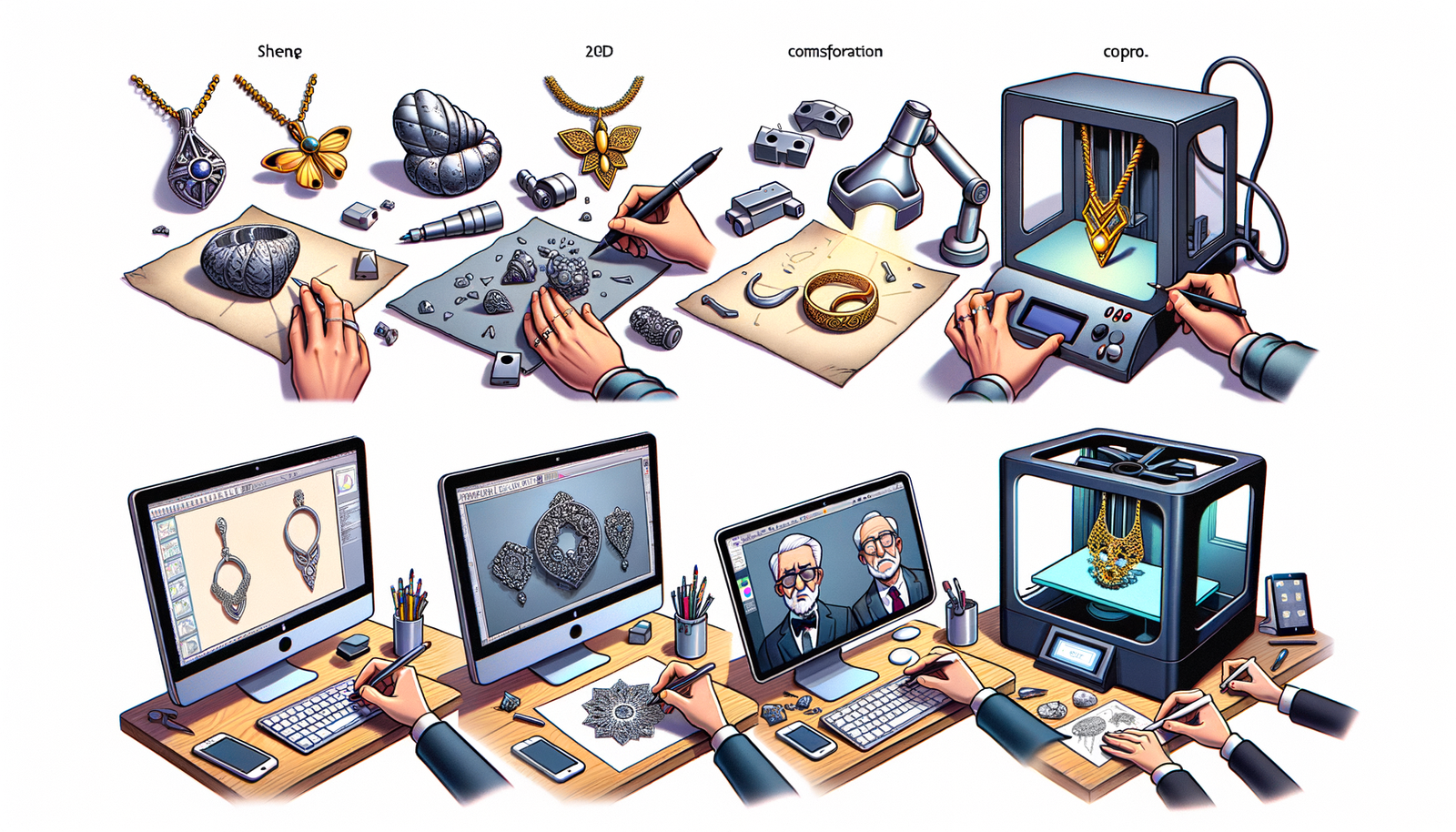Your Cart is Empty
Customer Testimonials
-
"Great customer service. The folks at Novedge were super helpful in navigating a somewhat complicated order including software upgrades and serial numbers in various stages of inactivity. They were friendly and helpful throughout the process.."
Ruben Ruckmark
"Quick & very helpful. We have been using Novedge for years and are very happy with their quick service when we need to make a purchase and excellent support resolving any issues."
Will Woodson
"Scott is the best. He reminds me about subscriptions dates, guides me in the correct direction for updates. He always responds promptly to me. He is literally the reason I continue to work with Novedge and will do so in the future."
Edward Mchugh
"Calvin Lok is “the man”. After my purchase of Sketchup 2021, he called me and provided step-by-step instructions to ease me through difficulties I was having with the setup of my new software."
Mike Borzage
Design Software History: The Evolution of CAD in Jewelry Design: Transforming Tradition Through Technology and Innovation
February 20, 2025 10 min read


Setting the Scene
For centuries, the art of jewelry design has been steeped in tradition, relying heavily on the skilled hands of artisans. Designers sketched their visions on paper, and master craftsmen painstakingly brought these ideas to life through methods passed down over generations. Techniques such as wax carving, lost-wax casting, and hand fabrication demanded not only artistic talent but also immense patience and precision. This process, while producing exquisite pieces, was inherently labor-intensive and time-consuming. Any alterations in design required starting anew, making experimentation and customization challenging. The limitations of manual techniques often constrained creativity, as certain intricate designs were nearly impossible to realize by hand.
Enter the advent of computer-aided design (CAD), a technological breakthrough that began to permeate the jewelry industry in the late 20th century. CAD emerged as a transformative force, revolutionizing how jewelers conceptualize and create their works. With CAD, designers could craft detailed 3D models of their pieces, allowing for unprecedented precision and the ability to visualize complex designs before any physical work commenced. This technology enabled the creation of intricate and elaborate patterns that were previously unattainable, pushing the boundaries of creativity and innovation in jewelry design. The integration of design software not only enhanced the efficiency of the design process but also opened new horizons for customization and personalization, catering to individual customer desires with ease.
Key Players
At the forefront of the digital revolution in jewelry design were several pioneering companies and individuals who recognized the potential of CAD technology in this niche field. One such company, Gemvision, founded by Jeff High in 1990, became instrumental in bringing advanced design software to jewelers worldwide. Gemvision’s flagship product, Matrix, was one of the first CAD programs specifically tailored for jewelry design, combining the robust modeling capabilities of Rhinoceros 3D with specialized tools for creating intricate jewelry pieces. Matrix allowed designers to visualize and modify detailed models with precision, significantly streamlining the design process.
Another key player was JewelCAD, developed by a team led by Dr. Peter Hu at Jewellery CAD/CAM Limited. Introduced in the late 1980s, JewelCAD was among the pioneering software solutions dedicated to jewelry design, offering user-friendly interfaces that made it accessible to designers with varying levels of technical expertise. The software facilitated the creation of complex free-form shapes and surfaces, which were particularly challenging to achieve with traditional methods.
Companies like Autodesk also contributed by developing versatile CAD platforms such as 3ds Max and Fusion 360, which, although not exclusive to jewelry, provided powerful tools that could be adapted for jewelry modeling. The collaboration between software developers and the jewelry industry led to advancements that addressed specific needs, such as the ability to render photorealistic images and prepare models for 3D printing. These early adopters and innovators laid the groundwork for integrating CAD into jewelry design, transforming it from a manual craft into a sophisticated blend of artistry and technology. Their contributions not only enhanced design capabilities but also set new industry standards for precision and efficiency.
The Dawn of CAD in Jewelry Design
The late 20th century marked a pivotal moment for the jewelry industry as it began to embrace the burgeoning field of computer-aided design. The initial applications of CAD in jewelry were met with both excitement and skepticism. Early adopters saw the potential for CAD to revolutionize the design process, providing tools that could handle the intricate and detailed nature of jewelry creation. Traditional design methods, while artistically rich, often lacked the efficiency and precision that modern markets demanded. The growing complexity of consumer tastes called for designs that were both elaborate and customizable, pushing the boundaries of what could be achieved manually.
Early CAD software had to address the specific needs of jewelry designers, who required not just basic modeling capabilities but also tools that could accurately represent the unique characteristics of precious metals and gemstones. This included the ability to model organic shapes, simulate intricate settings, and calculate the physical properties of materials. Software innovations such as parametric modeling allowed designers to adjust dimensions and proportions dynamically, greatly enhancing flexibility. The introduction of high-resolution rendering provided photorealistic images of designs, which was instrumental in client presentations and approvals.
One of the significant innovations during this period was the development of specialized modules within existing CAD platforms. For example, the integration of jewelry-specific functions into Rhinoceros 3D through plugins like RhinoGold enabled designers to leverage advanced modeling tools tailored to their craft. These innovations bridged the gap between general-purpose CAD software and the specialized requirements of jewelry design, facilitating broader adoption within the industry.
Challenges and Breakthroughs
While the integration of CAD into jewelry design offered immense potential, it was not without significant challenges. One of the primary technical hurdles was the adaptation of software originally designed for industrial manufacturing to suit the delicate and intricate nature of jewelry. Early CAD programs lacked the finesse required for modeling the complex organic shapes and minute details characteristic of fine jewelry. Moreover, the high learning curve associated with CAD software presented a barrier for many traditional jewelers, who were accustomed to hands-on design processes rather than digital interfaces.
Creative challenges also emerged, as some designers found the initial software constraints limiting to their artistic expression. The rigidity of early CAD systems often failed to capture the fluidity and uniqueness of handcrafted pieces. Additionally, the precision of CAD, while beneficial for accuracy, sometimes led to designs that lacked the subtle imperfections and nuances that give hand-crafted jewelry its charm.
However, continuous industry feedback played a crucial role in addressing these issues. Software developers collaborated closely with jewelers to understand their specific needs, leading to technological advances that bridged the gap between digital and traditional design methods. Enhancements such as improved user interfaces, more intuitive modeling tools, and the incorporation of haptic feedback devices made software more accessible and aligned with designers' creative workflows. The integration of parametric design capabilities allowed for more flexibility and experimentation, enabling designers to easily modify and iterate on their creations. These breakthroughs were instrumental in increasing the adoption of CAD in the jewelry industry, transforming initial skepticism into widespread acceptance. As software became more sophisticated and user-friendly, it empowered designers to push creative boundaries while maintaining the highest standards of precision and quality.
Core Technological Advancements
The evolution of jewelry design software has been significantly shaped by core technological advancements in solid modeling and geometric modeling. Solid modeling, which creates representations of the volume of an object, allowed jewelers to work with precise 3D models that accurately reflect the physical properties of the final product. This was a substantial shift from wireframe or surface modeling, providing a more complete and manipulable digital model. Geometric modeling, on the other hand, facilitated the creation of complex shapes and forms through mathematical representations, enabling designers to craft intricate patterns and organic structures with precision.
The integration of precision tools like 3D printing has further revolutionized the design and manufacturing process. 3D printing technology allowed designers to produce rapid prototypes directly from their CAD models, significantly reducing the time from concept to physical model. Materials such as wax or resin could be used to create detailed prototypes suitable for casting, streamlining traditional manufacturing workflows. This technology not only enhanced efficiency but also expanded the possibilities for complex designs that would be difficult or impossible to produce by hand.
Virtual prototyping and simulation have played a crucial role in refining jewelry design. Designers can now simulate how a piece will look and function before it is physically created. This includes visualizing the setting of gemstones, assessing the ergonomics of rings and bracelets, and ensuring structural integrity. Such simulations help identify potential issues early in the design process, saving time and resources. Additionally, photorealistic rendering allows for high-quality visual presentations, aiding in marketing and customer engagement by providing clients with a clear vision of the final product.
Advantages of 3D printing in jewelry design include:
- Rapid prototyping reduces time from concept to physical model.
- Enables production of complex designs difficult to achieve by hand.
- Streamlines traditional manufacturing workflows through direct casting from printed models.
Innovative Design Processes
The advent of parametric and iterative design methods in jewelry software has significantly transformed the creative process. Parametric design allows designers to define models based on parameters and rules, enabling the easy modification of dimensions and properties throughout the design. This approach supports rapid exploration of design variations, fostering innovation and efficiency. For instance, altering the size of gemstones or adjusting the curvature of a band can be done quickly without redrawing the entire model, facilitating a more fluid design process.
Software has also greatly facilitated customization and personalization in jewelry design. With the ability to easily modify designs, jewelers can offer clients bespoke pieces tailored to their preferences. This level of customization was previously limited due to the constraints of manual fabrication. CAD software empowers designers to accommodate specific requests, such as incorporating personal symbols, adjusting settings for unique gemstones, or engraving intricate patterns. The ease of customization has opened new market opportunities and enhanced client satisfaction.
Mathematical models play an essential role in achieving complex structural designs that were once considered unfeasible. Advanced algorithms allow for the creation of intricate lattice structures, generative designs, and organic forms inspired by nature. Techniques such as algorithmic modeling and computational design enable the creation of patterns and structures guided by mathematical principles. For example, using fractal geometry or parametric equations, designers can generate complex, repeating patterns with precision and consistency. These capabilities have elevated the artistic potential of jewelry design, merging the boundaries between art, mathematics, and technology.
Advantages of parametric design:
- Enables rapid modification of design dimensions and properties.
- Facilitates exploration of multiple design variations efficiently.
- Enhances flexibility in responding to client customization requests.
Contemporary Trends
In today's jewelry industry, contemporary trends are heavily influenced by advances in technology and software capabilities. Modern jewelry designers are leveraging cutting-edge tools that integrate artificial intelligence (AI) and machine learning to push creative boundaries and improve efficiency. AI-driven design software can analyze vast datasets of design elements and customer preferences to suggest innovative design ideas or optimize existing ones. Tools such as Autodesk's "Dreamcatcher" and "Generative Design" enable designers to input specific constraints and objectives, with the software generating multiple design solutions that meet the defined criteria.
The integration of AI and machine learning has enhanced both creativity and efficiency. By automating routine tasks and providing intelligent suggestions, designers can focus more on the artistic aspects of their work. AI algorithms can predict structural weaknesses, optimize material usage, and even forecast market trends, aiding designers in making informed decisions. Additionally, these technologies facilitate mass customization, allowing for the efficient production of personalized jewelry at scale.
User interfaces and usability have also significantly impacted the designer's creative potential. The development of more intuitive and user-friendly software has made advanced design tools accessible to a broader range of designers, including those with less technical expertise. Touch-based interfaces, virtual reality (VR), and augmented reality (AR) are being integrated into design software, offering immersive experiences that mimic the tactile sensations of traditional crafting. For example, haptic feedback devices enable designers to "feel" the virtual materials they are manipulating, bridging the gap between digital and physical design processes. These advancements have expanded creative possibilities and made the design process more engaging and interactive.
Benefits of AI in jewelry design:
- Automates routine tasks to enhance efficiency.
- Generates innovative design ideas through data analysis.
- Predicts structural issues and optimizes material usage.
- Facilitates mass customization and personalization.
Looking Forward
As the jewelry industry continues to evolve, future trends and innovations in design software are poised to further transform the landscape. One significant area of development is the increased use of augmented reality (AR) and virtual reality (VR) technologies. These immersive tools offer the possibility of designing and visualizing jewelry in a fully interactive 3D space. Designers can manipulate models in real-time within a virtual environment, enhancing spatial understanding and fostering greater creativity. Clients can also experience virtual try-ons, seeing how a piece will look on them before it is crafted, which enhances the buying experience and reduces uncertainty.
Cloud computing is another technology with substantial potential impact on jewelry design. Cloud-based platforms enable collaborative design processes, where multiple stakeholders can access, contribute to, and modify designs from different locations. This facilitates global collaboration, reduces barriers to entry for smaller designers who may not have access to high-end hardware, and ensures that the latest software updates and features are readily available. Additionally, cloud computing supports powerful computational capabilities for tasks such as rendering and simulation, which can be resource-intensive on local machines.
Evolving software will undoubtedly continue to redefine design boundaries in jewelry. Advancements in computational design, such as generative design and fabrication, will enable the creation of highly complex and customized pieces that blend art with science. The integration of bio-inspired designs, responsive materials, and smart technology will open new avenues for innovation. As technology advances, the line between designer and technologist may blur, necessitating new skill sets that combine artistic sensibility with technical proficiency. The ongoing evolution will likely lead to more personalized, sustainable, and innovative jewelry designs that reflect both individual expression and technological advancement.
Technologies shaping the future of jewelry design:
- Augmented Reality (AR) for interactive design and client visualization.
- Virtual Reality (VR) for immersive design experiences.
- Cloud Computing for collaborative design and computational resources.
- Generative Design and AI for innovative and complex creations.
Summarizing the Revolution
In conclusion, the integration of design software into the jewelry industry has fundamentally transformed every aspect of the design and manufacturing process. From the initial spark of an idea to the final crafted piece, technology has enabled designers to push creative boundaries, enhance precision, and streamline workflows. CAD and related technologies have democratized design, making advanced tools accessible to a wider range of creators and facilitating a level of customization and personalization previously unattainable.
Despite the significant technological advancements, the essence of artistry remains at the heart of jewelry design. Technology serves as a powerful tool that extends the capabilities of designers, but it is the human touch—the creativity, emotion, and vision of the designer—that imbues each piece with unique value. The balance between technology and artistry is essential, ensuring that while innovation drives the industry forward, the craft's rich heritage and personal expression continue to shine.
As technology continues to evolve, we can anticipate even more exciting developments in jewelry design. The continued fusion of advanced software, materials science, and manufacturing techniques will open new frontiers, allowing designers to realize visions that were once only imaginable. Ultimately, the revolution in jewelry design is an ongoing journey, one that celebrates both the timeless nature of personal adornment and the endless possibilities of technological innovation.
Also in Design News

Cinema 4D Tip: Cinema 4D: Export Multi‑Layer OpenEXR for AOV‑Driven ACES/OCIO Compositing
December 21, 2025 2 min read
Read More
V-Ray Tip: VFB Color Corrections Pass for Non-Destructive, Consistent Grading
December 21, 2025 2 min read
Read More
Revit Tip: Worksharing Display Modes — Visualize Ownership, Checkout Status, Model Updates, and Worksets
December 21, 2025 2 min read
Read MoreSubscribe
Sign up to get the latest on sales, new releases and more …


